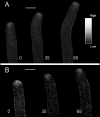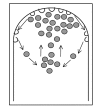Correlative Analysis of [Ca](C) and Apical Secretion during Pollen Tube Growth and Reorientation
- PMID: 19521495
- PMCID: PMC2635010
- DOI: 10.4161/psb.1.3.2999
Correlative Analysis of [Ca](C) and Apical Secretion during Pollen Tube Growth and Reorientation
Abstract
The maintenance of a cytosolic free calcium gradient (Ca(2+)](c)) and vesicle secretion in the apex of pollen tubes is essential for growth. It has been postulated that high [Ca(2+)](c) levels promote and confine vesicle fusion with the apical plasma membrane and in this study we performed a correlative analysis of both events using specific fluorescent dyes and confocal scanning microscopy. [Ca(2+)](c) was imaged with Calcium Green-1 10 kDa dextran (CG-1) while secretory events were followed with FM1-43 or FM4-64 in pollen tubes undergoing normal growth and reorientation events.During straight growth (no modification in direction), we found that changes in apical [Ca(2+)](c) accompany changes in apical FM fluorescence indicating a tight coupling between [Ca(2+)](c) and apical secretion. This coupling seems however to be perturbed during periods of reorientation of the pollen tube growth axis. Analysis of apical and sub-apical fluorescent signals during the reorientation events and subsequent re-entry in straight growth indicate that the increase in secretory events (higher fusion rate) precede the increases in [Ca(2+)](c) that should be required for the transduction of the signal.Based on these findings, we discuss a model for membrane secretion and recycling which considers the apical and sub-apical region as a functional area containing all the elements required to promote and sustain growth.
Keywords: FM1–43; [Ca2+]c; cFM4–64; endocytosis; exocytosis; secretion; tip growth.
Figures





References
-
- Malhó R, Castanho Coelho P, Pierson E, Derksen J. Endocytosis and membrane recycling in pollen tubes. In: Samaj J, Baluska F, Menzel D, editors. The Plant Endocytosis. Germany: Springer-Verlag; 2005. pp. 277–291.
-
- Monteiro D, Liu Q, Lisboa S, Scherer GEF, Quader H, Malhó R. Phosphoinositides and phosphatidic acid regulate pollen tube growth and reorientation through modulation of [Ca2+]c and membrane secretion. J Exp Bot. 2005;56:1665–1674. - PubMed
-
- Rathore KS, Cork RJ, Robinson KR. A cytoplasmic gradient of Ca2+ is correlated with the growth of Lily pollen tubes. Develop Biol. 1991;148:612–619. - PubMed
LinkOut - more resources
Full Text Sources
Miscellaneous
